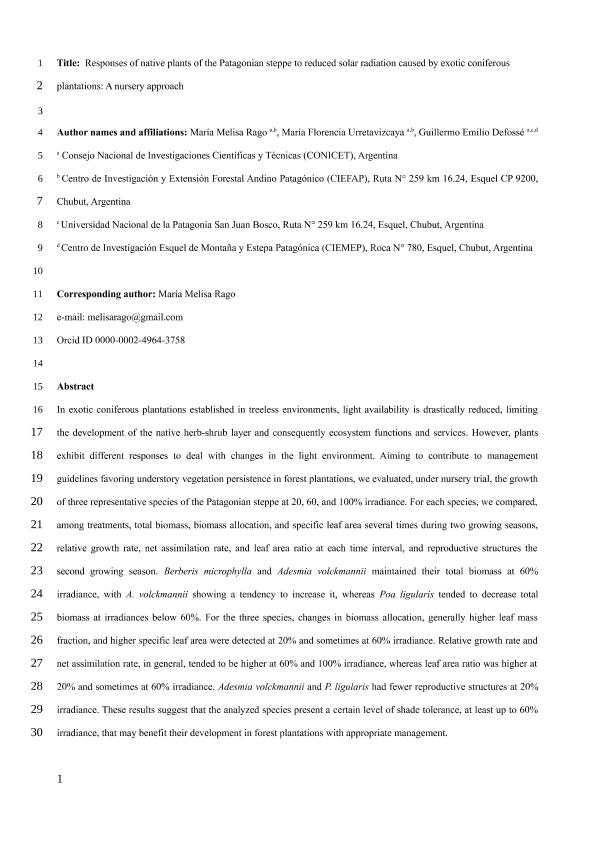Mostrar el registro sencillo del ítem
dc.contributor.author
Rago, María Melisa

dc.contributor.author
Urretavizcaya, María Florencia

dc.contributor.author
Defossé, Guillermo Emilio

dc.date.available
2023-05-16T13:10:35Z
dc.date.issued
2022-12
dc.identifier.citation
Rago, María Melisa; Urretavizcaya, María Florencia; Defossé, Guillermo Emilio; Responses of native plants of the Patagonian steppe to reduced solar radiation caused by exotic coniferous plantations: a nursery approach; Springer; European Journal of Forest Research; 12-2022; 1-15
dc.identifier.issn
1612-4669
dc.identifier.uri
http://hdl.handle.net/11336/197665
dc.description.abstract
In exotic coniferous plantations established in treeless environments, light availability is drastically reduced, limiting the development of the native herb–shrub layer and consequently ecosystem functions and services. However, plants exhibit different responses to deal with changes in the light environment. Aiming to contribute to management guidelines favoring understory vegetation persistence in forest plantations, we evaluated, under nursery trial, the growth of three representative species of the Patagonian steppe at 20, 60, and 100% irradiance. For each species, we compared, among treatments, total biomass, biomass allocation, and specific leaf area several times during two growing seasons, relative growth rate, net assimilation rate, and leaf area ratio at each time interval, and reproductive structures the second growing season. Berberis microphylla and Adesmia volckmannii maintained their total biomass at 60% irradiance, with A. volckmannii showing a tendency to increase it, whereas Poa ligularis tended to decrease total biomass at irradiances below 60%. For the three species, changes in biomass allocation, generally higher leaf mass fraction, and higher specific leaf area were detected at 20% and sometimes at 60% irradiance. Relative growth rate and net assimilation rate, in general, tended to be higher at 60 and 100% irradiance, whereas leaf area ratio was higher at 20% and sometimes at 60% irradiance. Adesmia volckmannii and P. ligularis had fewer reproductive structures at 20% irradiance. These results suggest that the analyzed species present a certain level of shade tolerance, at least up to 60% irradiance, that may benefit their development in forest plantations with appropriate management.
dc.format
application/pdf
dc.language.iso
eng
dc.publisher
Springer

dc.rights
info:eu-repo/semantics/openAccess
dc.rights.uri
https://creativecommons.org/licenses/by-nc-sa/2.5/ar/
dc.subject
BIODIVERSITY CONSERVATION
dc.subject
BIOMASS ALLOCATION
dc.subject
FOREST MANAGEMENT
dc.subject
HERBS AND SHRUBS PRODUCTIVITY
dc.subject
LIGHT
dc.subject
RELATIVE GROWTH RATE
dc.subject.classification
Ecología

dc.subject.classification
Ciencias Biológicas

dc.subject.classification
CIENCIAS NATURALES Y EXACTAS

dc.title
Responses of native plants of the Patagonian steppe to reduced solar radiation caused by exotic coniferous plantations: a nursery approach
dc.type
info:eu-repo/semantics/article
dc.type
info:ar-repo/semantics/artículo
dc.type
info:eu-repo/semantics/publishedVersion
dc.date.updated
2023-05-16T11:24:41Z
dc.journal.pagination
1-15
dc.journal.pais
Alemania

dc.description.fil
Fil: Rago, María Melisa. Consejo Nacional de Investigaciones Científicas y Técnicas; Argentina. Centro de Investigación y Extensión Forestal Andino Patagónico; Argentina
dc.description.fil
Fil: Urretavizcaya, María Florencia. Centro de Investigación y Extensión Forestal Andino Patagónico; Argentina. Consejo Nacional de Investigaciones Científicas y Técnicas; Argentina
dc.description.fil
Fil: Defossé, Guillermo Emilio. Consejo Nacional de Investigaciones Científicas y Técnicas. Centro Científico Tecnológico Conicet - Patagonia Norte. Centro de Investigación Esquel de Montaña y Estepa Patagónica. Universidad Nacional de la Patagonia "San Juan Bosco". Centro de Investigación Esquel de Montaña y Estepa Patagónica; Argentina
dc.journal.title
European Journal of Forest Research

dc.relation.alternativeid
info:eu-repo/semantics/altIdentifier/doi/http://dx.doi.org/10.1007/s10342-022-01523-y
Archivos asociados
